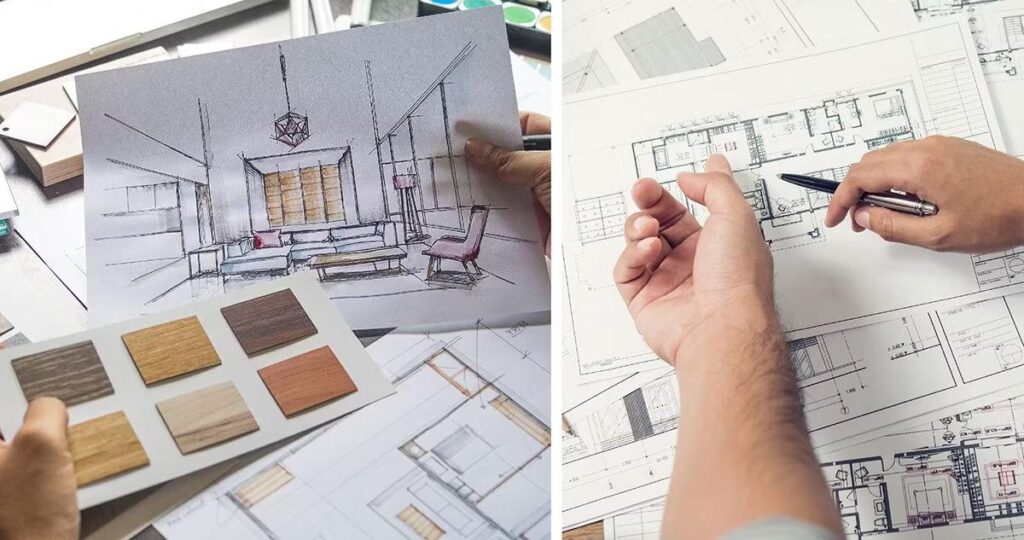Physical Address
304 North Cardinal St.
Dorchester Center, MA 02124
Physical Address
304 North Cardinal St.
Dorchester Center, MA 02124

In this journey of unlocking the secrets of becoming an interior designer, whether through a conventional degree or a return to school, I will be your guide into the enchanting realm of design and unravel the steps that lead to a thriving career in interior aesthetics.
The realm of interior design encompasses the fusion of art and science, delving into the intricacies of comprehending human behavior to formulate functional spaces within a structure. In contrast, interior decorating entails the embellishment and furnishing of a given space with decorative elements, all orchestrated to achieve a specific aesthetic appeal.
Succinctly put, while interior designers may engage in decorating endeavors, decorators, in essence, do not engage in the comprehensive process of design.
Buckle up for a ride through creativity, craftsmanship, and the unexpected twists that make this path uniquely yours.
Embark on the adventure by getting crystal clear on the kind of interior designer you aspire to be. Navigate the networks of regulations in your locale, and let go of the misconception that a degree is the only ticket to success. Understand how your style and portfolio speak louder than formal education, especially when weaving dreams for private abodes.
Your design journey takes flight with the creation of a portfolio, the magnum opus showcasing your prowess. Dive into the art of crafting mood boards—those visual symphonies that capture your design essence. Learn the delicate method of choosing images that not only resonate with your vision but also dazzle when mixed together.
Presenting a portfolio provides a platform to exhibit your flexibility and capacity to adapt, highlighting a diverse array of projects or skill sets. This enables you to distinguish yourself from competitors, demonstrating to prospective employers your ability to navigate the dynamic terrain of evolving technology.

Avoid the frustration and uncertainty of trying to figure everything out on your own. Instead, leverage proven CRO strategies, captivating designs, and scientific customer acquisition methods to grow your business.

Equip yourself with the architectural language of design. Learn the intricate art of technical drawings—floor plans and elevations—the blueprints that breathe life into your visions. Master the use of a scale ruler, for in the world of design, meticulous documentation is the key to realizing your creations.
A proficient interior designer should possess the skill to comprehend architectural blueprints and the ability to modify or independently create them. Precision, accuracy, and adherence to scale are imperative when drafting plans, demanding a keen eye for detail and a mastery of the technical aspects of design
Become a connoisseur of design solutions and products. Immerse yourself in the local design landscape by frequenting showrooms and forging relationships with suppliers. Uncover the secrets of pricing, availability, and the art of sourcing unique products that set your designs apart.
In the symphony of design, timing is everything. Resist the urge to bid farewell to your day job prematurely. Ensure a financial safety net before taking the plunge into full-time design, allowing yourself the luxury of learning, honing skills, and building that stellar portfolio.
Approximately 70% of aspiring young professionals harbor the ambition of initiating their entrepreneurial ventures. However, the harsh truth remains that over two-thirds of these startup endeavors fail to yield a favorable return on investment for their backers. Therefore, prior to contemplating the resignation from one’s current employment to embark on the journey of introducing a new product or service, a multitude of factors necessitate consideration.
■ Assess the feasibility of your conceptualization.
■ Establish your professional network at an early stage.
■ Equip yourself with emotional preparedness.
■ Acknowledge that ingenuity often surpasses financial investment.
■ Verify the soundness of your personal financial situation.Let the creative juices flow by practicing your design wizardry. Whether it’s transforming your own space or collaborating with friends and family, every project is a stepping stone in your design evolution. Don’t wait for a natural talent; instead, let your skills bloom through relentless practice.
In the collaborative world of design, social skills are your secret weapon. Build connections, earn trust, and remember that each project is a dance with architects, clients, suppliers, and contractors. Master the art of human interaction, for it’s often the unseen force that seals the deal.
Navigate the realm of design software with finesse. Start with Photoshop, the versatile brush in your digital palette. While there’s a myriad of software out there, don’t overwhelm yourself. Learn gradually, or consider outsourcing to professionals when complexity arises.
In the realm of interior design software, one encounters a spectrum of distinctive attributes, encompassing:
■ Visualization in both 2D and 3D dimensions
■ Comprehensive documentation capabilities
■ Seamless import and export of files
■ Efficient data extraction functionalities
■ An array of drawing and sketching tools
■ Advanced modeling and rendering capabilitiesIn the cacophony of design voices, stand out with a brand that echoes your unique style. From your website to social media and business cards, let your brand speak volumes about your design philosophy. Remember, recognition starts with a strong visual identity.

A Comprehensive Manual For Crafting a Robust Interior Design Brand:
■ Clearly outline your target clientele.
■ Validate the distinctiveness of your brand.
■ Actively engage in and support industry associations.
■ Foster connections within professional organizations.
■ Feature guest articles on prominent blogs or websites.
■ Produce authentic content.
■ Enhance and refresh your public portfolio regularly.Harness the power of social media, but do it differently. Understand that 97% of impressions are fleeting. Discover alternative methods that captivate your audience, ensuring your design story doesn’t drown in the scrolling sea.
Interior designers leverage social media platforms not only to exhibit their portfolio but also to establish connections with prospective clients and stay abreast of the latest trends in the industry.
Various approaches are employed by interior designers on social media, encompassing the sharing of images showcasing accomplished projects, disseminating design inspirations, and providing glimpses into the intricacies of their creative processes.

Become a design evangelist. Reach out to friends, family, and every corner of your social network. Unleash the power of recommendation and don’t shy away from self-promotion. You are not an imposter; you are an aspiring designer on a mission.
Check this: Amazing Stylish Small Café Interior Design |Low-Budget Tips
As the curtain falls on this design thread, remember that the journey of becoming an interior designer is as unique as your design fingerprint. Embrace the unpredictability, savor the learning curve, and dance to the rhythm of your creative heartbeat. Now, armed with the wisdom of these steps, go forth and craft your design destiny. The canvas awaits your distinctive strokes.
Indeed, acquiring knowledge about the essence of interior design and the responsibilities associated with being an interior designer is plausible without pursuing a structured educational route. However, for those aspiring to engage in professional practice, venturing into this realm without the guidance of a formal education resembles embarking on an extended and possibly deficient expedition.
To gain official registration, interior designers must possess a minimum of an associate degree. The pursuit of this educational milestone imparts foundational knowledge encompassing construction, design theory, historical perspectives, as well as communication and business skills. Additionally, designers have the opportunity to acquire proficiency in diverse trade tools, including computer-aided design (CAD), by engaging in self-paced online courses.
Certainly, one can delve into the realm of becoming a self-taught interior designer through the pursuit of concise courses. Embracing online learning is a viable avenue for autonomously exploring the nuances of interior design. I propose this approach as a noteworthy option, considering the plethora of excellent brief courses currently available, with some even offering complimentary access.
Typically, adept interior designers adhere to an array of informal guidelines derived from distinct interior design principles and components. These components encompass space, line, forms, light, color, texture, and pattern; maintaining equilibrium among them is pivotal for crafting an interior that is visually appealing.
Achieving licensure as an interior designer involves successfully completing the National Council for Interior Design Qualification (NCIDQ) examination. This state-endorsed assessment requires candidates to meet eligibility criteria based on a blend of educational and experiential qualifications. Generally, candidates need a bachelor’s degree coupled with a two-year on-the-job training period to qualify for this pivotal examination.